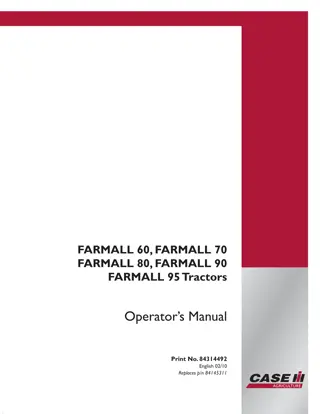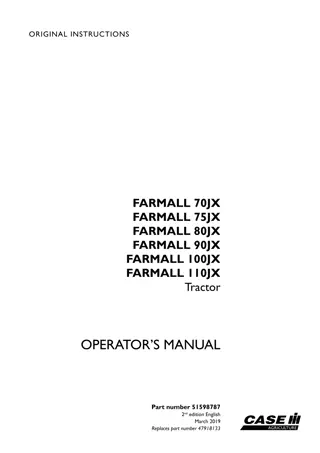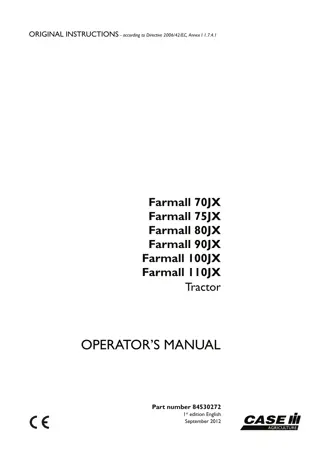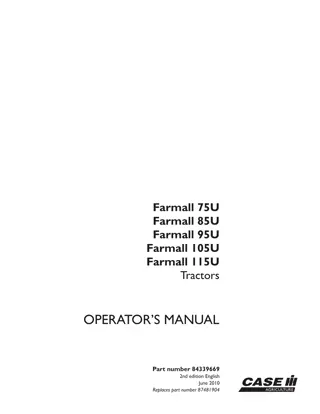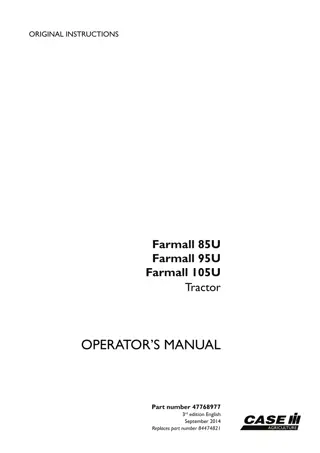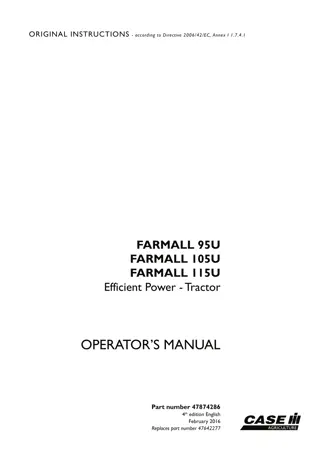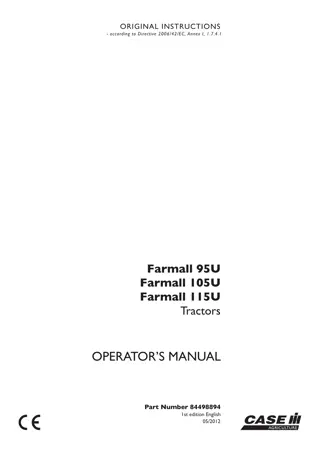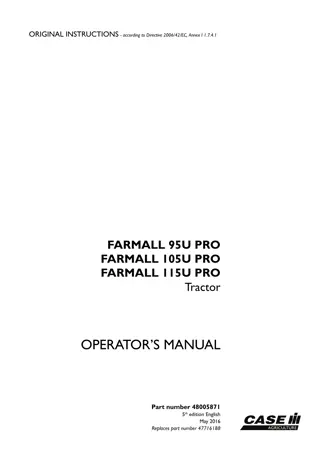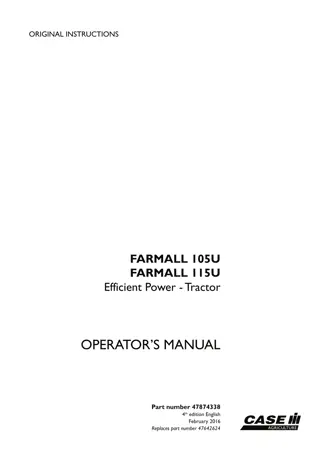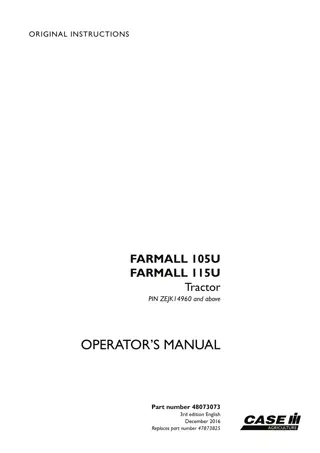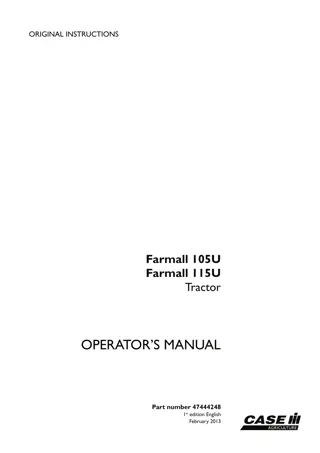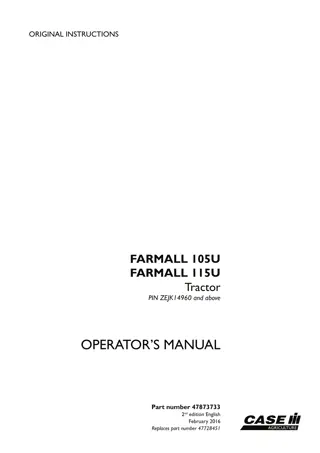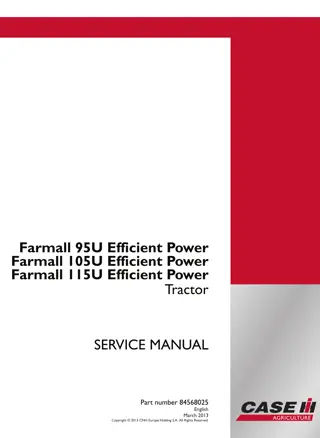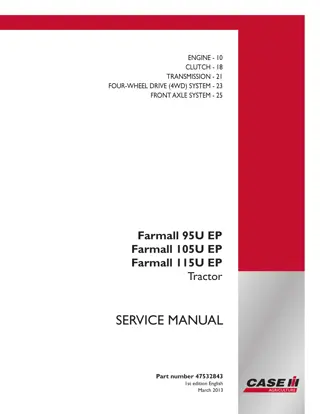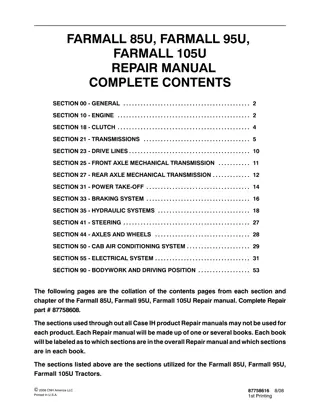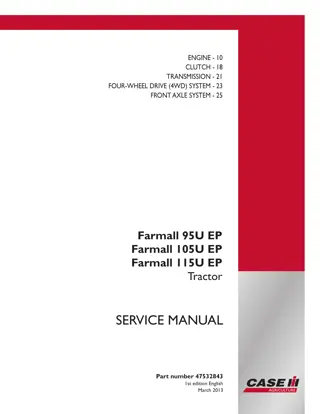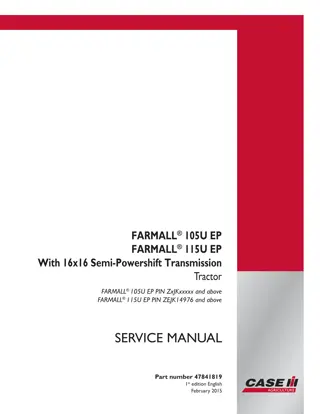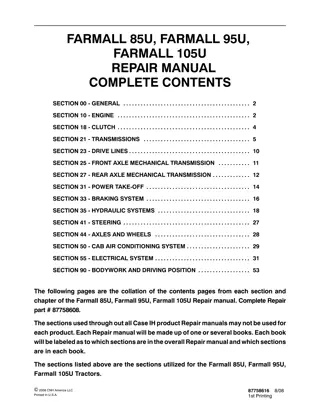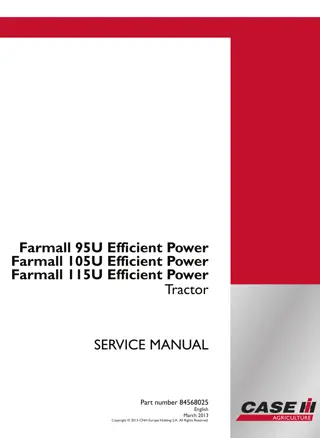
CASE IH Farmall 95U Efficient Power, Farmall 105U Efficient Power, Farmall 115U Efficient Power Tractor Service Repair Manual Instant Download
Please open the website below to get the complete manualnn//
Download Presentation

Please find below an Image/Link to download the presentation.
The content on the website is provided AS IS for your information and personal use only. It may not be sold, licensed, or shared on other websites without obtaining consent from the author. Download presentation by click this link. If you encounter any issues during the download, it is possible that the publisher has removed the file from their server.
E N D
Presentation Transcript
SERVICE MANUAL Farmall 95U Farmall 105U Farmall 115U Efficient Power Tractor Farmall 95U Efficient Power Farmall 105U Efficient Power Farmall 115U Efficient Power Tractor Part number 84568025 1/3 SERVICE MANUAL Part number 84568025 English March 2013 Copyright 2013 CNH Europe Holding S.A. All Rights Reserved.
SERVICE MANUAL Farmall 105U EP Farmall 115U EP Farmall 95U EP 84568025 22/03/2013 EN
Link Product / Engine Product Market Product North America Europe International Region North America Europe International Region Europe International Region Engine Farmall 105U EP Farmall 105U EP Farmall 105U EP F5DFL413B*A006 F5DFL413B*A006 F5DFL413B*A006 Farmall 115U EP Farmall 115U EP Farmall 115U EP F5DFL413A*A002 F5DFL413A*A002 F5DFL413A*A002 Farmall 95U EP Farmall 95U EP F5DFL413C*A003 F5DFL413C*A003 84568025 22/03/2013
https://www.ebooklibonline.com Hello dear friend! Thank you very much for reading. Enter the link into your browser. The full manual is available for immediate download. https://www.ebooklibonline.com
Contents INTRODUCTION Engine....................................................................................... 10 [10.001] Engine and crankcase ............................................................. 10.1 [10.414] Fan and drive ...................................................................... 10.2 [10.501] Exhaust Gas Recirculation (EGR) - Diesel Particulate Filter (DPF) exhaust treatment .................................................................................... 10.3 Clutch ....................................................................................... 18 [18.112] Slip clutch or flywheel damper ..................................................... 18.1 Transmission.............................................................................. 21 [21.118] Transmission/Rear drive ........................................................... 21.1 [21.112] Power shuttle transmission......................................................... 21.2 [21.104] Power shuttle transmission lubrication system..................................... 21.3 [21.134] Power shuttle transmission external controls ...................................... 21.4 [21.148] Transmission/Rear drive internal components..................................... 21.5 [21.154] Power shuttle transmission internal components .................................. 21.6 [21.145] Gearbox internal components...................................................... 21.7 [21.160] Creeper ............................................................................ 21.8 [21.168] Hi-Lo unit........................................................................... 21.9 Four-Wheel Drive (4WD) system .................................................. 23 [23.202] Electro-hydraulic control ........................................................... 23.1 [23.304] Four-Wheel Drive (4WD) gearbox ................................................. 23.2 [23.314] Drive shaft.......................................................................... 23.3 Front axle system ....................................................................... 25 [25.100] Powered front axle ................................................................. 25.1 [25.102] Front bevel gear set and differential ............................................... 25.2 [25.108] Final drive hub, steering knuckles, and shafts ..................................... 25.3 Rear axle system........................................................................ 27 84568025 22/03/2013
[27.100] Powered rear axle.................................................................. 27.1 [27.106] Rear bevel gear set and differential................................................ 27.2 [27.120] Planetary and final drives .......................................................... 27.3 Power Take-Off (PTO)................................................................. 31 [31.104] Rear electro-hydraulic control...................................................... 31.1 [31.116] Three-speed rear Power Take-Off (PTO) .......................................... 31.2 [31.114] Two-speed rear Power Take-Off (PTO) ............................................ 31.3 Brakes and controls .................................................................... 33 [33.202] Hydraulic service brakes ........................................................... 33.1 [33.204] Front axle brake.................................................................... 33.2 [33.110] Parking brake or parking lock ...................................................... 33.3 [33.220] Trailer brake hydraulic control...................................................... 33.4 Hydraulic systems....................................................................... 35 [35.000] Hydraulic systems.................................................................. 35.1 [35.355] Hydraulic hand control ............................................................. 35.2 [35.204] Remote control valves ............................................................. 35.3 [35.114] Three-point hitch control valve ..................................................... 35.4 Hitches, drawbars, and implement couplings.................................. 37 [37.110] Rear three-point hitch .............................................................. 37.1 Steering..................................................................................... 41 [41.200] Hydraulic control components...................................................... 41.1 [41.206] Pump............................................................................... 41.2 [41.216] Cylinders ........................................................................... 41.3 Wheels...................................................................................... 44 [44.511] Front wheels........................................................................ 44.1 Electrical systems....................................................................... 55 [55.000] Electrical system ................................................................... 55.1 84568025 22/03/2013
[55.100] Harnesses and connectors......................................................... 55.2 [55.201] Engine starting system............................................................. 55.3 [55.301] Alternator........................................................................... 55.4 [55.302] Battery.............................................................................. 55.5 [55.640] Electronic modules................................................................. 55.6 [55.024] Transmission control system....................................................... 55.7 [55.523] Cab hitch controls.................................................................. 55.8 [55.130] Rear three-point hitch electronic control system ................................... 55.9 [55.408] Warning indicators, alarms, and instruments .................................... 55.10 [55.DTC] FAULT CODES.................................................................. 55.11 Platform, cab, bodywork, and decals............................................. 90 [90.150] Cab................................................................................. 90.1 [90.100] Engine hood and panels ........................................................... 90.2 84568025 22/03/2013
INTRODUCTION 84568025 22/03/2013 1
INTRODUCTION Safety rules SAFETY REGULATIONS TO PREVENT ACCIDENTS Most accidents or injuries that occur in workshops are the result of non--observance of simple and fundamental safety regulations. For this reason, IN MOST CASES THESE ACCIDENTS CAN BE AVOIDED: by foreseeing possible causes and con- sequently acting with the necessary caution and care. Accidents may occur with all types of vehicle, regardless of how well it was designed and built. A careful and judicious service technician is the best guarantee against accidents. Precise observance of the most basic safety rule is normally sufficient to avoid many serious accidents. DANGER: Never carry out any cleaning, lubrication or maintenance operations when the engine is running. GENERAL Carefully follow specified repair and maintenance procedures. Do not wear rings, wristwatches, jewellery, unbuttoned or loose articles of clothing such as: ties, torn clothing, scarves, open jackets or shirts with open zips that may remain entangled in moving parts. It is advised to wear approved safety clothing, e.g: non--slip footwear, gloves, safety goggles, helmets, etc. Do not carry out repair operations with someone sitting in the driver s seat, unless the person is a trained technician who is assisting with the operation in question. Operate the vehicle and use the implements exclusively from the driver s seat. Do not carry out operations on the vehicle with the engine running, unless specifically indicated. Stop the engine and ensure that all pressure is relieved from hydraulic circuits before removing caps, covers, valves, etc. All repair and maintenance operations must be carried out using extreme care and attention. Service steps and platforms used in a workshop or in the field should be built in compliance with the safety rules in force. Disconnect the batteries and label all controls to indicate that the vehicle is being serviced. Block the machine and all equipment which should be raised. Do not check or fill fuel tanks, accumulator batteries, nor use starting liquid when smoking or near naked flames, as these fluids are inflammable. Brakes are inoperative if manually released for repair or maintenance purposes. In such cases, the machine should be kept constantly under control using blocks or similar devices. The fuel nozzle should always be in contact with the filling aperture. Maintain this position until filling operations are completed in order to avoid possible sparks caused by the accumulation of static electricity. Only use specified towing points for towing the tractor, connect parts carefully.Make sure that all pins and/or locks are secured in position before applying traction. Never remain near the towing bars, cables or chains that are operating under load Transport vehicles that cannot be driven using a trailer or a low--loading platform trolley, if available. When loading or unloading the vehicle from the trailer (or other means of transport), select a flat area capable of sustaining the trailer or truck wheels, firmly secure the tractor to the truck or trailer and lock the wheels in the position. Electric heaters, battery--chargers and similar equipment must only be powered by auxiliary power supplies with efficient ground insulation to avoid electrical shock hazards. Always use suitable hoisting or lifting devices when raising or moving heavy parts. Take extra care if bystanders are present. Never pour gasoline or diesel oil into open, wide and low containers. Never use gasoline, diesel oil or other inflammable liquids as cleaning agents. Use non-flammable non-toxic pro- prietary solvents. Wear safety goggles with side guards when cleaning parts with compressed air. Limit the air pressure to a maximum of 2.1 bar (30.5 psi), according to local regulations. 84568025 22/03/2013 4
INTRODUCTION Do not run the engine in confined spaces without suitable ventilation. Do not smoke, use naked flames, or cause sparks in the area when fuel filling or handling highly inflammable liquids. Never use naked flames for lighting when working on the machine or checking for leaks. All movements must be carried out carefully when working under, on or near the vehicle and wear protective equip- ment: helmets, goggles and special footwear. When carrying out checks with the engine running, request the assistance of an operator in the driver s seat. The operator must maintain visual contact with the service technician at all times. If operating outside the workshop, position the vehicle on a flat surface and lock in position. If working on a slope, lock the vehicle in position and move to a flat area as soon as is safely possible. Damaged or bent chains or cables are unreliable. Do not use them for lifting or towing. Always use suitable protective gloves when handling chains or cables. Chains should always be safely secured. Ensure that fastening device is strong enough to hold the load foreseen. No persons should stop near the fastening point, trailing chains or cables. Maintenanceandrepairoperationsmust becarriedout inaCLEANandDRY area, eliminateany wateroroilspillage immediately. Do not create piles of oil or grease--soaked rags as they represent a serious fire hazard; store them in a closed metal container. Before starting the vehicle or implements, make sure that the driver s seat is locked in position and always check that the area is free of persons or obstacles. Empty pockets of all objects that may fall unobserved into the vehicle parts when disassembled. In the presence of protruding metal parts, use protective goggles or goggles with side guards, helmets, special footwear and gloves. Handle all parts carefully, do not put your hands or fingers between moving parts, wear suitable safety clothing -- safety goggles, gloves and shoes. WELDING OPERATIONS When welding, use protective safety devices: tinted safety goggles, helmets, special overalls, gloves and footwear. All persons present in the area where welding is taking place must wear tinted goggles. NEVER LOOK AT THE WELDING ARC IF YOUR EYES ARE NOT SUITABLY PROTECTED. Where possible, remove the part or tool that requires arc welding from the tractor. Disconnect both battery leads. Isolate the cable ends to avoid contact with each other and the tractor. Position the welder ground clamp as near as possible to the area where welding is taking place. Remove the electronic control units located on the tractor if welding is to be carried out near these control units. Never allow welding cables to lay on, near or across any electrical wiring or electronic component while welding is in progress. Metal cables tend to fray with repeated use. Always use suitable protective devices (gloves, goggles, etc.) when handling cables. START UP Never start the engine in confined spaces that are not equipped with adequate ventilation for exhaust gas extraction. Never place the head, body, limbs, feet, hands or fingers near fans or rotating belts. ENGINE Always loosen the radiator cap slowly before removing it to allow any remaining pressure in the system to be dis- charged. Coolant should be topped up only when the engine is stopped or idle if hot. Never fill up with fuel when the engine is running, especially if hot, in order to prevent the outbreak of fire as a result of fuel spillage Never check or adjust fan belt tension when the engine is running. Never adjust the fuel injection pump when the vehicle is moving. 84568025 22/03/2013 5
INTRODUCTION Never lubricate the vehicle when the engine is running. ELECTRICAL SYSTEMS If it is necessary to use auxiliary batteries, remember that both ends of the cables must be connected as follows: (+) with (+) and (-) with (-). Avoid short-circuiting the terminals. GAS RELEASED FROM BATTERIES IS HIGHLY INFLAMMABLE. During charging, leave the battery compartment uncovered to improve ventilation. Never check the battery charge using jumpers (metal objects placed on the terminals). Avoid sparks or flames near the battery zone to prevent explosion hazards. Before servicing operations, check for fuel or current leaks. Eliminate any eventual leaks before starting work. Never charge batteries in confined spaces. Make sure that there is adequate ventilation in order to prevent acci- dental explosion hazards as a result of the accumulation of gases released during charging operations. Always disconnect the battery before performing any kind of servicing on the electrical system. HYDRAULIC SYSTEMS Some fluid slowly coming out from a very small port can be almost invisible and be strong enough to penetrate the skin. Check for leaks using a piece of cardboard, NEVER USE HANDS. If any liquid penetrates skin tissue, call for medical aid immediately Serious skin infections may result if medical attention is not given. Use the specific tools when checking pressure values on the hydraulic system. WHEELS AND TYRES Check that the tyres are correctly inflated at the pressure specified by the manufacturer. Periodically check possible damages to the rims and tyres. Stand away from (at the side of) the tire when checking inflation pressure. Only check pressure when the vehicle is unloaded and the tires are cold, to avoid incorrect readings as a result of over--pressure. Do not re--use parts of recovered wheels as incorrect welding or brazing may heat the material, causing it to weaken and eventually damage or break the wheel. Never cut, nor weld a rim with the inflated tyre assembled. When removing the wheels, lock both the front and rear vehicle wheels. Always position support stands when raising the vehicle, in order to conform to current safety regulations. Deflate the tyre before removing any object caught into the tyre tread. Never inflate tires using inflammable gases; this could cause an explosion and put operator safety at risk. REMOVAL AND RE-FITTING Lift and handle all heavy parts using suitable lifting equipment and make sure that all slings and hooks are correctly secured. Handle all parts carefully during lifting operations, keep an eye on the personnel working near the load to be lifted. Never insert hands or fingers between parts, always wear approved accident prevention clothing (goggles, gloves and work boots). Avoid twisting chains or metal cables and always wear safety gloves when handling cables or chains. 84568025 22/03/2013 6
INTRODUCTION Basic instructions SHIMMING For each adjustment operation, select adjusting shims and measure individually using a micrometer, then add up the measured values: Do not rely on measuring the entire shimming set, which may be incorrect, or the rated value indicated for each on shim. ROTATING SHAFT SEALS For correct rotating shaft seal installation, proceed as follows: thoroughly clean the shaft and check that the working surface on the shaft is not damaged; position the sealing lip facing the fluid; with hydrodynamic lips, take into consideration the shaft rotation direction and position the grooves so that they will deviate the fluid towards the inner side of the seal; coat the sealing lip with a thin layer of lubricant (use oil rather than grease) and fill the gap between the sealing lip and the dust lip on double lip seals with grease; insert the seal in its seat and press down using a seal installer; do not tap the seal with a hammer or mallet; whilst inserting the seal, check that it is perpendicular to the seat; once settled. to prevent damaging the seal lip on the shaft, position a protective guard during installation operations. O--RING SEALS Lubricate the O--RING seals before inserting them in the seats, this will prevent them from overturning and twisting, which would jeopardise sealing efficiency. SEALING COMPOUNDS Apply one of the following sealing compounds on the mating surfaces marked, on this manual, with an X: RTV 1473, RHODORSIL CAF 1 or LOCTITE PLASTIC GASKET. Before applying the sealing compound, prepare the surfaces as follows: remove any incrustations using a wire brush; WARNING Chemical hazard! Always wear protective clothing and goggles when cleaning with solvents, acids, or alkaline chem- ical agents. Always follow the chemical manufacturer's instructions. Failure to comply could result in death or serious injury. W0180A thoroughly de-grease the surfaces using one of the following cleaning agents: trichlorethylene, Diesel fuel or a water and sodium hydroxide ( NaOH , also known as caustic soda) solution. BEARINGS When installing bearings it is advised to: heat the bearings to 80 90 C before fitting on the shafts; allow the bearings to cool before installing them. SPRING PINS When fitting split socket elastic pins, ensure that the pin notch is positioned in the direction of the force required to stress the pin. Spiral spring pins do not require special positioning. 84568025 22/03/2013 7
INTRODUCTION IMPORTANT NOTES Wear limit values indicated for certain parts are recommended, but not binding. The terms front , rear , right--hand and left--hand (when referred to different parts) are intended as seen from the driving position with the tractor in the normal direction of movement. MOVING THE TRACTOR WITH THE BATTERY REMOVED External power supply cables should only be connected to the respective positive and negative cable terminals, using efficient clamps that guarantee adequate and secure contact. Disconnect all services (lights, windshield wipers, etc.) before starting the vehicle. If the vehicle electrical system requires checking, carry out operations with the power supply connected; Once checking is completed, disconnect all services and switch off the power supply before dis- connecting the cables. 84568025 22/03/2013 8
SERVICE MANUAL Engine Farmall 105U EP Farmall 115U EP Farmall 95U EP 84568025 22/03/2013 10
Engine - Engine and crankcase Engine - General specification GENERAL SPECIFICATIONS Engine, technical type: Farmall 95U Farmall 105U Farmall 115U Engine rpm - high - nominal - low Cycle Fuel injection Number of cylinders in line Bore - All models Piston diameter Piston stroke Total displacement: - All models Compression ratio All models Maximum Power Output: Farmall 95U Farmall 105U Farmall 115U Maximum power speed Peak torque Farmall 95U Farmall 105U Farmall 115U Peak torque speed Torque increase Farmall 95U Farmall 105U Farmall 115U Power at the power take off Farmall 95U Farmall 105U Farmall 115U Number of main bearings Sump Lubrication Pump drive Oil filtration Engine oil pressure switch operating pressures: - contacts closing* with decreasing pressure. - contacts opening* with increasing pressure. * with the contacts closed the engine oil pressure warning light is on Cooling closing Capacity Fan with viscous joint, fixed to the specific pulley Coolant pump Coolant thermometer Temperature ranges corresponding to each section: initial dark blue sector final red sector dark blue area Start of opening 4 Cylinders F5DFL413C*A003 F5DFL413B*A006 F5DFL413B*A002 2400 - 2500 RPM 2300 RPM 700 - 800 RPM diesel, 4-stroke Direct 4 99 mm (3.8976 in) 110 mm (4.3307 in) 3400 cm 17 0.5 : 1 73 kW (99 Hp) 79 kW (107 Hp) 84 kW (114 Hp) 2300 RPM 407 N m (300.19 lb ft) 444 N m (327.48 lb ft) 461 N m (340.02 lb ft) 1500 RPM 34 % 35 % 32 % 62.7 kW (85.1 Hp) 68.6 kW (93.3 Hp) 73.9 kW (100.4 Hp) 5 structural, cast iron forced, with lobe pump from crankshaft mesh screen on oil intake and filter cartridge on delivery line 0.2 bar (2.90 psi) 0.9 bar (13.05 psi) coolant circulation with five rows of vertical pipes 16 l (4.23 US gal) 520 mm (20.4724 in) intake, in plastic with 10 blades colored scale divided into three sections normal temperature high temperature via thermostat valve 80 C (176.00 F) 84568025 22/03/2013 10.1 [10.001] / 3
Engine - Engine and crankcase GENERAL SPECIFICATIONS 4 Cylinders Timing overhead valves operated by tappets, rods and rocker arms via the camshaft located in the engine block; the camshaft is driven by the crankshaft using straight-tooth gears Intake: start: before P.M.S. end: after P.M.I. Exhaust: start: before P.M.I. end: after P.M.S. Clearance between valves and rocker arms with engine cold. Turbocharging Air cleaning 19 37 61 21 The valve clearance is hydraulically controlled. Therefore, manual adjustment is not necessary. Turbocharged with intercooler dual cartridge dry air cleaner, with clogged filter indicator with centrifugal pre-filter and automatic dust ejector by mesh prefilter on the supply pipe, suction line filter with water - fuel separator, low pressure filter and sensor. Manual mounted on the suction line filter BOSCH High pressure Common Rail control unit HPCR - CP4.1 Electro-injectors 300 - 1400 bar (4350.00 - 20300.00 psi) Fuel filtration Priming pump Injection pump Type Nozzles type Injection pressure Filling: Engine sump Fuel tank Anti-pollution system Type: 6.4 - 8.1 l (1.69 - 2.14 US gal) 140 l (36.98 US gal) Exhaust gas recycling system EGR Particulate filter DPF* every 3000 hours Recommended frequency for renewing filter NOTE: * - For filter maintenance please refer to: ( Diesel Particulate Filters (DPF) - Dynamic description manual regeneration of the diesel particulate filter (DPF) (55.408)) 84568025 22/03/2013 10.1 [10.001] / 4
Engine - Engine and crankcase Engine - Remove 1. Removethehood(1)asindicatedinHood-Remove (90.100) 2. Free the bottom steps of the ladder with the retainer (1), raise it with the knob (2), take off the battery cover, detach the battery negative cable. 1 WLAPL4S10C101A 3. Remove the split pins, retaining pin and front ballast assembly (1) from the support. 2 WLAPL4S10C102AA 4. Unscrew the fixing screws (1) and remove the front wheel mudguards (2) (if applicable) Do this on both sides. 3 WLAPL4S10C104A 5. Remove the fixing bolts (1) and detach the engine left-hand side panel (2). Carry out the same opera- tion for the right hand side panel too. Remove the glove compartment. 4 WLAPL4S10C105A 84568025 22/03/2013 10.1 [10.001] / 5
Engine - Engine and crankcase 6. Recover the refrigerant from the system via the connections (1) and (2) using the specific tool 380000315. Detach the pipe (1), clear the section of brackets and clamps, move it onto the condenser ( (1), 6), detach the pipe (2), clear the section and take it to the cab. 5 WLAPL4S10C106AA 7. Subsequently go onto the front detach the lower pipe (3) on the condenser (1) free it from any straps or clamps, disconnect the sensor (2) and take it to the cab. 6 WLAPL4S10C107A 8. Drain the fuel from the tank by removing the bottom drain plug. 7 WLAPL4S10C108A 9. Unscrew the fixing bolts (1) and remove the right- hand steps (2). 8 WLAPL4S10C109A 84568025 22/03/2013 10.1 [10.001] / 6
Engine - Engine and crankcase 10. Raise the rear of the tractor with a hydraulic jack, put amechanicalstandunderthereductionunitbox, with a pneumatic gun remove the left-hand rear wheel retaining nuts, and subsequently take off the wheel. 9 WLAPL4S10C110A 11. Detach the tank retaining straps (1), mark and de- tach the fuel pipes (2) and extract the fuel tank (3). Remove also the bottom tank guard (4) 10 WLAPL4S10C111A 12. Unscrew the front central and rear retaining bolts on the front axle shaft guard, then remove the guard (1). 11 WLAPL4S10C112AA 13. Remove the circlip (2) and move the front sleeve (1) in the direction indicated by the arrow until it is re- leased from the groove on the front axle. 12 WLAPL4S10C113AA 84568025 22/03/2013 10.1 [10.001] / 7
Engine - Engine and crankcase 14. Remove the circlip (2) retaining the coupling sleeve of the propeller shaft (1) on the back, move the sleeve on the shaft. 13 WLAPL4S10C114AA 15. Take out the screws fixing the central support (1) of thepropellershaftandremovetheshafttogetherwith the support, remove also the shaft end float adjuster shim on the back. 14 WLAPL4S10C115AA 16. Loosen the union of the cab heater radiator coolant return pipe, drain and collect the engine coolant. 15 WLAPL4S10C116A 17. Take out the plug (1) and drain the oil from the gear- box--transmission casing. 16 WLAPL4S10C117A 84568025 22/03/2013 10.1 [10.001] / 8
Engine - Engine and crankcase 18. Loosen the device joining the outlet on the filter DPF, free the outlet tube from any brackets fastening it to the cab and remove it. 17 WLAPL4S10C118A 19. Loosen the fixing clamps (1) and extract the pipe from the turbine to the radiator intercooler (2). Carry out the same operation for the pipe from the radiator intercooler to the engine (3). 18 WLAPL4S10C119A 20. Loosen the clamp (2) fastening the air intake pipe to the turbine, then free the air cleaner (4) together with the support bracket (3) from the screws fixing it. Disconnecttheoilvaporpipe(1)ontheleft-handside of the engine at the level of the fuel pump; remove it all. 19 WLAPL4S10C120A 21. Free the air cleaner bracket - casing support (1) from the fixing screws and remove it. 20 WLAPL4S10C121A ATTENTION: The filter outlet union DPF (1) at its terminal (2) has a decoupler, that reacts, when the temperature changes, only lengthwise. 84568025 22/03/2013 10.1 [10.001] / 9
Engine - Engine and crankcase A small misalignment of the axis of the decoupler with respect to the axis of the turbine outlet (3) would produce an adjustment that would no longer be lengthwise, in line with the direction of the tractor, but abnormal transversal adjustment that would impair its durability. 22. Disconnect all the filter sensors, loosen the clamp (4), remove the entire filter together with the sen- sors, pressure sensing tubes, lambda probe and heat guards by undoing the four screws (5) fixing it on the bottom cradle. 21 WLAPL4S10C122A ATTENTION: Only if you have to work on the parts under- neath the DPF support, it is advisable to remove the sup- port. The top part (1) and the right-hand part (2) should be re- moved as a block, when possible, by removing the fixing screws (3) to the right of the engine (these screws work on a vertical slot that allows the support (2) to take on various positions in height). Before disassembly, take some ref- erences on the position of the unit on the engine, so that during reassembly it is possible to restore it to the exact position in which it was first found. 22 WLAPL4S10C123A 23. To remove the rear guard, unscrew the two upper screws fastening the support (4) support (1), to re- move the left support, (5) unscrew the two upper screws for the centering bushings and that secure the left bracket to the support (1). As regards removing the support (1) and (2) there are no special instructions to follow. 23 WLAPL4S10C124A 24. Detach the steering system pipes (1) and (2) and the pipe delivering oil to the spool valve (3). Remove the fasteners of the bracket (4) from the en- gine 24 WLAPL4S10C125A 84568025 22/03/2013 10.1 [10.001] / 10
Engine - Engine and crankcase 25. Detach the power steering spool valve outlet pipe on the gearbox spool valve (2), on the same filter detach the gearbox spool valve supply pipe (1). Subsequently remove the filter together with the sup- port (3). 25 WLAPL4S10C126A 26. Disconnect the intake pipes from the pump (1) on the pump itself, the oil filter intake pipe from the trans- mission (2), on the junction under the transmission, at the height of the cab support. Disconnect the delivery line to the lift (3) again at the height of the pipe (2). Detach the delivery pipes (5) to the lift and to the power steering anti-cavitation tank (6) on the pump. 27. Detach the unit together with the filter (4), tank (6), support and the parts of piping disconnected previ- ously. 28. Detach the high pressure - power steering pump unit. 26 WLAPL4S10C127A 29. Detach the pipes of the cooler (1), differential lock (3) and, if applicable, front braking assembly (4). 30. Free the pipes previously detached from the sup- ports, brackets and clamps secured to the engine, do the same thing also for the pipes directed to the steering system cylinder (2). 27 WLAPL4S10C128A 31. On the right-hand side, detach the cab heating pipes, (1), the pipe inserted on the engine sleeve. (3) com- ing from the expansion tank, then, loosen the clamps and, on the engine, detach the lower (4) and upper rubber sleeves joining radiator - engine. 28 WLAPL4S10C134A 84568025 22/03/2013 10.1 [10.001] / 11
Engine - Engine and crankcase 32. On the right-hand side, remove the guard (1) on the starter motor (2), disconnect the starting cable, the battery cut-off switch, the cable joining it to the alter- nator, also disconnect the alternator and the battery positive terminal, free all the wirings detached from the various clamps. 33. Detach the clamp bolt (3) then remove the ground cables of the engine and battery system, remove the other clamp bolts of the motor and remove it. 29 WLAPL4S10C135A 34. On the cable (1) of the FTP cable - engine interface detach all the connections (2), leave only those on the maxi fuse box and on the glow plug control unit, then, after cutting the clamps, collect the cable on the front near the control unit (5). 35. On the main engine cable (3) disconnect the connec- tors, starting from the one on the control unit (4), from the maxi fuse box and from the various switches and sensors located on the engine and, after freeing it from the clamps, move it onto the back at the height of the right-hand steps. 30 WLAPL4S10C137A 36. On the left-hand side disconnect the connector of the power cable of the cab (1), free it from the clamps and move it onto the maxi fuse box. 37. Detach the bracket (2) supporting the cab connec- tors, cab power and cup filter (3), disconnect the pipe that joins the latter to the mechanical priming pump on the sediment filter. 31 WLAPL4S10C139A 38. Hook the rear part of the engine onto a hoist using chains or ropes for the hoisting (apply two eye bolts, one to the right and one to the left, on the upper part of the flange containing the flywheel). Position a fixed stand (2) under the clutch housing (1) near the engine attachment flanging and apply the hand- brake. 32 WLAPL4S10C129A 84568025 22/03/2013 10.1 [10.001] / 12
Engine - Engine and crankcase 39. Position the movable tool for dismantling tractors 380000569 (2) with the bracket and adapter plate under the engine and place a wooden block (1) in between the points of contact between the tool and engine. Wedge the axle to prevent swinging. 33 WLAPL4S10C140A 40. Remove the fixing screws (1) between the engine and the transmission. 34 WLAPL4S10C130A 41. Separate the engine (1) from the transmission with the tool 380000569 (2). 35 WLAPL4S10C131AA 42. Insert the fixed stand (1) under the ballast support and secure the front wheels with wooden blocks (2). 36 WLAPL4S10C132AA 84568025 22/03/2013 10.1 [10.001] / 13
Engine - Engine and crankcase 43. Position a fixed stand (3) under the support of the groove (1) of the front axle drive placing a wooden plug between parts (3) and (1). 37 WLAPL4S10C133A 44. Set a stand under the back of the engine so as to be able to release the hoist with the coupling device in full safety. Add a rope or chain also on the front of the engine and take up the slack with the lifting device, keeping the engine balanced. 38 WLAPL4S10C136A 45. Remove the bolts (1) fastening the front axle support (2) to the engine. Remove the adjuster spacers for the support - monobloc (4) / sump (3). 39 WLAPL4S10C141A 46. Check that there are no brackets between the engine and the cooling assembly, detach the engine (2) from thefrontaxle, (3)tryingtoavoidincorrectmovements with the hoist in order not to damage the radiator fins (1) with the engine fan. Rest the engine (2) on a support. 40 WLAPL4S10C138A 84568025 22/03/2013 10.1 [10.001] / 14
Engine - Engine and crankcase 47. Remove the viscous coupling (1), where applicable, together with the fan (2). 41 WLAPL4S10C144A 48. Loosenthecompressorfixingscrews(4), removethe belt (5), then remove the compressor. 49. Completely unscrew the belt tensioner (2), remove the flexible belt (3), then remove the alternator (1). 42 WLAPL4S10C145A 84568025 22/03/2013 10.1 [10.001] / 15
Engine - Engine and crankcase Engine - Install 1. - Refit the flexible belt on the alternator and take up the slack according to the procedure in Accessory belt - Tension adjust belt (55.301). 2. - Reposition the compressor and the relevant belt following this procedure: - Reposition the compressor on the support and with the relevant pipe support secure it with the screws - To fit the belt polyv use the tool 380200011. (1). Compressor clutch actuator drive bracket. (2). polyv belt pulley outer edge. (3). Tool recess. It is used to drive the tool; this recess houses the bracket (1). (4). Tail. Used to drive the polyv belt in the pulley seat. (5). Hitching. Thanks to this recess, where the outer edge (2) is housed, the tool remains hitched to the compressor. 1 WLAPL4S10C101C 84568025 22/03/2013 10.1 [10.001] / 16
Engine - Engine and crankcase 3. - Take out the bolts (1) and the related compressor clutch dust cover. 2 WLAPL4S10C142A 4. Make sure that the polyv (2) belt is perfectly housed on the fan pulley. 5. -Movethebelt(2)neartothecompressorpulleyand, keeping the tool 380200011 under the belt, hook it onto the clutch of the compressor at the innermost part so as to slightly force the belt. 3 WLAPL4S10C143A 6. - With your left hand on the fan and right hand on the tool, move both clockwise so as to take the belt onto the belt of the compressor. - Put the dust cup back onto the compressor clutch and tighten the three screws taking care to spread a film of thread lock on the ends so they do not come unscrewed. 7. - Where applicable, reposition the viscous joint and the cooling fan. 8. - Apply the required torque settings ( see engine sec- tion) 9. - Insert the three hooks of the chain in the eyelets on the engine and, using the hoist, lift the assembly off the platform support. 10. - Position the engine on the front axle, trying to avoid incorrect operations with the hoist so as not to let the engine fan damage the fins of the radiator, then join the two assemblies together with the four retain- ing bolts and the necessary adjuster spacers for the monobloc/sump support. 11. - Reposition the movable tool for dismantling tractors 380000569 under the engine and place a wooden block in between the point of contact between the tool and engine. 84568025 22/03/2013 10.1 [10.001] / 17
Engine - Engine and crankcase 12. - With the aid of the hoist, place the engine on the tool 380000569 and remove the lifting eye bolts pre- viously fitted on the rear of the engine. 13. -Removethefixedstandpreviouslypositionedunder the support of the groove of the drive of the front axle and the wooden plug. 14. - Remove the fixed U--bolt fitted beforehand under the ballast support and the two wooden wedges lock- ing the front wheels. 15. - Remove the old sealing paste from the two surfaces between the engine and clutch casing. 16. - Apply LOCTITE 518 sealing compound on the en- gine and clutch casing mating surfaces. 17. - Put a wooden block under the right-hand rear wheel, make sure that the handbrake is fully applied and that all fixed and mobile stands are safely posi- tioned. 18. - The installation phase described here requires the presence of two or three workers to use the movable tool for dismantling tractors 380000569 to move the engine/front axle assembly close to the gearbox. 19. - In the phase of installing the engine/front axle as- sembly to the gearbox, it is necessary to push on the front wheels, taking great care in the end phase of coupling over both the pipes and the cables/electri- cal connections to prevent crushing between the two bodies. During this phase, it is moreover necessary to turn the crankshaft with the aid of the radiator cool- ing fan to help the coupling between the sleeve and the drive shaft. 20. - Secure both assemblies by tightening all the bolts locking the engine to the gearbox. 21. -Disconnectthehoistchains, removetheU--boltpre- viously fitted under the clutch casing and recover the movable tool for dismantling tractors 380000569. 22. - Refit the bracket supporting the cab connectors, cab power and cup filter, connect the pipe that joins the latter to the mechanical priming pump on the sed- iment filter. 23. - On the left-hand side, connect the cab power cable connector, take it onto the maxi fuse box and lock it with clamps. 24. - Return the main engine cable back into position, connect the connectors to the sensors and switches located on the engine, on the control unit and on the maxi fuse box, fasten the wiring with clamps. 25. - Lay out the FTP interface - engine cable on the ma- chine, reconnect the various connections and secure the wiring with clamps. 26. - Fit the starter motor back on, then connect the two ground wires on the engine and battery system. 84568025 22/03/2013 10.1 [10.001] / 18
Suggest: If the above button click is invalid. Please download this document first, and then click the above link to download the complete manual. Thank you so much for reading
Engine - Engine and crankcase 27. - On the right-hand side reconnect the battery posi- tive cable and the wirings to the starter motor, battery cut-off switch and alternator. Fit the guard back onto the starter motor. 28. - Refit the two delivery and return lines to the cab heater and the pipe inserted on the lower sleeve coming from the expansion tank. Refit the upper and lower sleeves of the radiator engine connection. Se- cure the straps and clamps tightening the pipes. 29. - Reconnect the power steering spool valve oil fil- ter together with the support. Reconnect the power steering oil drain pipe and the supply pipe to the spool valve of the gearbox. 30. - Refit the two oil delivery and return pipes to the cooler and secure them with the relevant clamp. 31. - Reassemble the power steering pump. Fit back on the transmission oil filter assembly and fix the screws, reconnect the delivery piping to the lift and to the power steering anti-cavitation assembly on the pump, theoilfilterinletfromthetransmission, andthe two suction lines from the filter to the pump. 32. - Connect the pipes to the power steering cylinder and the supply to the spool valve. 33. - If it was necessary to remove the DPF support pro- ceed as follows: 1 Mount the upper support (1) on the right one (2) with the three Allen screws. 2 Mount the left support (5) securing it to the engine with the three lower screws. 3 Mount the assembly of the supports (1) and (2) to the engine with the four screws in position (3), re- specting the reference marks made when disman- tling. 4 Secure the support (5) to the support (1) with the two upper screws with the two adjustment bushings. 5 Mount the support (4) to the engine with the two lower screws, fasten the three left screws to the sup- port (5) and with the two upper screws to the support (1) 4 WLAPL4S10C124A 34. - Fit the DPF filter assembly back on, returning the entire unit into position and fastening the four fixing screws of the assembly to the cradle. Observation: If after refitting the DPF filter you find a slight mis- alignment with the axis of the turbine, it is possible to make a correction. On the two screws fixing the fil- ter to the cradle there are two threaded bushings (2) held in position by a grub screw (1). Loosen the grub screw with an Allen wrench, screw the bushing in or out by the amount necessary to correct the misalignment, retighten the grub screw and fix the support. 5 WLAPL4S10C146A 35. - Refit the upper bracket supporting the casing and secure it with the relevant screws. 84568025 22/03/2013 10.1 [10.001] / 19
https://www.ebooklibonline.com Hello dear friend! Thank you very much for reading. Enter the link into your browser. The full manual is available for immediate download. https://www.ebooklibonline.com

